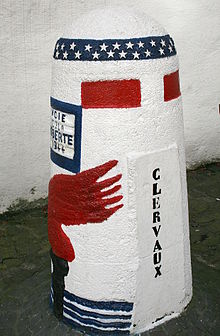Liberty Road is the commemorative way marking the victorious route of the Allied forces from D-Day in June 1944. It starts in Sainte-Mère-Église, in the Manche département in Basse-Normandie, France, travels across Northern France to Metz and then northwards to end in Bastogne, on the border of Luxembourg and Belgium. At each of the 1,146 kilometres, there is a stone marker or 'Borne'. The first lies outside the town hall in Sainte-Mère-Église.
History
Soon after the end of the Second World War, Mr Guy de la Vasselais, French liaison officer to George S. Patton, suggested the idea of erecting a monument to commemorate the Liberation of France by the American Armies, and to honor the soldiers who sacrificed much in so doing: a monument that would symbolize the idea of Liberty. However he thought that a single monument would be inappropriate to express the immense gratitude of the French people toward their Liberators. He therefore suggested the installation of a distinctive marker placed at each kilometer interval along the roads followed by General Patton’s Third United States Army.
Beginning at Utah Beach in Normandy and ending at Bastogne in Belgium, the Liberty Road goes through the cities of Saint Malo, Rennes, Angers, Le Mans, Chartres, Fontainebleau, Reims, Verdun and Metz, and then through the Grand Duchy of Luxembourg. Altogether the Monument consists of 1146 Milestones. The design of these Milestones, though simple, is most symbolic: The Flaming Torch of the Statue of Liberty, emerging from the sea, is carried eastward. Along the circumference of the Milestone’s dome-shaped top, the 48 stars of the United States Flag remind us that brave men from each state of that great Nation took part in the Liberation of France.
The “Liberty Highway” was officially opened on September 17, 1947 at Fontainebleau, by Mr Paul Ramadier, then President du Conseil, in the presence of Mr Jefferson Caffery, United States Ambassador to France and members of the American Legion.
Many military and civilian dignitaries of the Allied Nations were also present at the ceremonies.
Forty years later, the Liberty Monuments still stand proudly along those French roads. President Ronald Reagan, accompanied by many heads of State, came in 1984 to mark the 40th anniversary of D-Day. All stood to meditate at the site where the first American troops landed to restore Liberty to France. Since the dedication of the Liberty Highway in 1947, millions of visitors have come to visit these Monuments and to remember.
Route

Borne number one, on the sands of Utah Beach.

Born of the Liberty Road of Clervaux.
These are the towns, villages and notable places along the route:
- Sainte-Mère-Église (liberated during the nights of 5 and 6 June, it is the starting point marked by the first kilometre 'borne'.
- Utah Beach
- Sainte-Marie-du-Mont, Manche is the town where the first German blockhouse was taken.
- Neuville-au-Plain was the first village liberated by the U.S. paratroopers.
- Montebourg liberated on 19 June 1944.
- Cherbourg liberated on 26 June 1944.
- Carentan liberated on 12 June 1944.
- Pont-Hébert liberated on 17 July 1944.
- Saint-Lô liberated on 16 July 1944. General Patton launched his offensive towards Avranches, towards Brittany and towards the Loire.
- Marigny liberated on 25 July 1944.
- Coutances liberated on 28 July 1944.
- Lengronne liberated on 29 July 1944, a scene of a violent tank battle.
- Avranches liberated on 30 July 1944, subjected to a German counter-attack. It is known as the Breach of Avranches.
- Saint-Servan liberated on 17 August 1944, where the Germans occupied the powerfully armed city fortress.
- Saint-Malo liberated on 16 August 1944, which was completely destroyed (especially the part within the walls).
- Rennes liberated on 4 August 1944.
- Angers liberated on 10 August 1944.
- Le Mans liberated on 8 August 1944.
- Chartres liberated on 18 August 1944.
- Saint-Symphorien, Cher, almost midway between Sainte-Mère-Église and Bastogne, had the honour of receiving the first 'borne'. On 25 August 1946, its mayor, Guy de la Vasselais was the proposer of Liberty Road.
- Étampes liberated on 22 August 1944.
- Fontainebleau liberated on 23 August 1944.
- Épernay liberated on 28 August 1944.
- Reims liberated on 30 August 1944. The Germans signed an unconditional surrender, at what is now Grand Quartier Général Eisenhower. The Salle de la Reddition is the precise location.
- Valmy liberated on 30 August 1944.
- Verdun, Meuse, became in October 1944, one of the two largest American supply depots.
- Gravelotte liberated on 13 December 1944.
- Nancy liberated on 15 September 1944.
- Rozérieulles liberated on 20 November 1944 and noted as among the most stubborn German resistance.
- Metz liberated on 19 November 1944.
- Thionville liberated on 12 September 1944.
- Luxembourg City liberated on 10 September 1944.
- Arlon liberated on 10 September 1944.
- Bastogne, the end of the Voie de la Liberté, at 1,145 km from Sainte-Mère-Église. It was liberated on 10 September 1944.
Activities
A bicycle ride of the Voie de la Liberté has taken place every other year, since 1986, in order to remember the soldiers who made the ultimate sacrifice so that Nazism would be forever banished.
References
- This article is based on a translation of an article from the French Wikipedia.
- VOIE de la LIBERTÉ - Historic and Tourist Guide - Grandes Editions Françaises - Paris - 1947
External links
| Wikimedia Commons has media related to Liberty Road (France). |
- (English) History of Liberty Road in France and sale of "Bornes of Liberty"
- (English) (French) Bicycle ride on Liberty Road in France
- (French) Bicycle ride on Liberty Road in Belgium
The original article can be found at Liberty Road (France) and the edit history here.